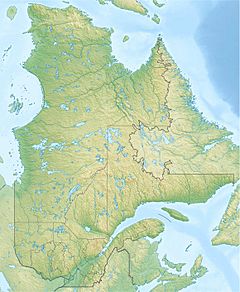Gros Mécatina River facts for kids
Quick facts for kids Gros Mécatina River |
|
|---|---|
| Other name(s) | Rivière du Gros Mécatina |
| Country | Canada |
| Province | Quebec |
| Region | Côte-Nord |
| RCM | Le Golfe-du-Saint-Laurent |
| Physical characteristics | |
| Main source | Lac Boucher 51°06′35″N 59°27′02″W / 51.109670°N 59.450554°W |
| River mouth | Gulf of Saint Lawrence 50°46′06″N 59°05′40″W / 50.7683333°N 59.0944444°W |
| Length | 55 kilometres (34 mi) |
| Basin features | |
| Basin size | 1,054 square kilometres (407 sq mi) |
The Gros Mécatina River (also known as Rivière du Gros Mécatina in French) is a cool river in the Côte-Nord region of Quebec, Canada. It's famous for its salmon! This river flows right into the huge Gulf of Saint Lawrence.
Contents
Where is the Gros Mécatina River?
The Gros Mécatina River is about 55 kilometres (34 mi) long. It starts in a lake called Lac Boucher. This lake is about 15 kilometres (9.3 mi) east of the Little Mecatina River.
The river winds and twists through many lakes. It generally flows towards the southeast. Finally, it empties into the Gulf of St. Lawrence. This happens near a group of islands called the Gros Mécatina Archipelago. These islands are west of a bay called Baie des Moutons and the village of Mutton Bay.
The land near Mutton Bay has hills that are almost 270 metres (890 ft) high. The mouth of the Gros Mécatina River is in a town called Gros-Mécatina. This town is part of the Le Golfe-du-Saint-Laurent Regional County Municipality. The Gros Mécatina Archipelago is in the Gulf, just southeast of where the river meets the sea.
The area drained by the river is called its basin. This basin covers 1,054 square kilometres (407 sq mi). It includes parts of the unorganized territory Petit-Mécatina. It also includes parts of the towns of Côte-Nord-du-Golfe-du-Saint-Laurent and Gros-Mécatina. Lac du Gros Mecatina is a lake not far from the river's mouth. Other lakes in this area include Lac Bernadette, Lac Talbot, and Lac Boucher. You can also find Lac Garin, Lac Doris, Lac Arabian, Lac Levêque, and Lac Grenville here.
What Does "Mécatina" Mean?
The name "Mécatina" comes from the Innu language. The Innu word is makatinau. It means "big mountain."
Back in 1694, a famous explorer named Louis Jolliet used the name Mecatinachis. He used it for the island of Petit Mécatina. The words Petit (Small) and Gros (Big) were used later. They helped tell apart two trading posts in the 1700s.
In 1739, Jean-Baptiste Pommereau was given land at Gros Mécatinat. Then, in 1740, Henri-Albert de Saint-Vincent got land at Petit Mecatina. The English later called the rivers that led to these posts the Big Mecatina River and Little Mecatina River.
Protecting the Gros Mécatina River Area
There's a plan to create a special area called the Harrington Harbor Biodiversity Reserve. This reserve would be in the river's watershed. This means it would help protect the land and water around the river.
There's also a bird sanctuary called the Gros-Mécatina Migratory Bird Sanctuary. This sanctuary protects several islands. These include Plate Island, Trois Collines Island, Marmette Islands, and Rocks. This area is fully protected, and people are not allowed to access it.
The Canadian government owns this sanctuary. It follows special laws like the Migratory Birds Convention Act and the Canada Wildlife Act. These laws help protect birds that travel long distances. The parts of the Gros Mécatina River and the Véco River that are affected by tides are also managed by this bird sanctuary.
Fishing in the Gros Mécatina River
People started commercial fishing on the Gros Mécatina River in 1749. The river was known for its many high-quality fish. These included brook trout (Salvelinus fontinalis) and Atlantic salmon (Salmo salar).
The salmon swim up the river until they reach a large waterfall. This waterfall is about 20 kilometres (12 mi) from the river's mouth. A company called Pourvoirie Mécatina has special rights to fish in this part of the river.
There are about 20 spots where you can catch fish. You can fish here between July and September. Anglers often wade on rocks to fish. Between 2012 and 2016, about 90 young salmon and 4 large salmon were caught each year.
In 2017, people were allowed to keep large salmon during the second part of the fishing season. The river did very well in 2018. It caught more salmon than expected! So, in July 2018, the government announced a special rule for August. Anglers could keep one large salmon, 63 centimetres (25 in) or longer. This rule applied to the Gros Mécatina and other rivers like the Napetipi and Saint-Paul.


